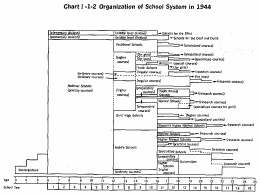| Home > Policy > White Paper, Notice, Announcement > White Paper > JAPANESE GOVERNMENT POLICIES IN EDUCATION,SCIENCE AND CULTURE 1989 > PART |
||
With the termination of World War ![]() in 1945, along with the
reform of other sectors of societv, the educational svstem of Janan faced the
formidable task of reform amid the postwar devastation.
in 1945, along with the
reform of other sectors of societv, the educational svstem of Janan faced the
formidable task of reform amid the postwar devastation.
Educational ideals for a new Jarpan were much discussed, despite under ihecontrol of the Occupation Force of the Allied Powers. By 1952 when the indepemdence of the nation was restored, the framework of a new educational system was almost complete with basic laws and ordinances introduced in stages.
The Constitution of Japan was promulgated in 1946, which stipulated access to education as one of the fundamental rights of the people. It thus consolidated the basis for compulsory education.
The Fundamental Law of Education was enacted in 1947. The law incorporated new educational ideals introduced by the Constitution such as equaFity ofeducational opportunities, compulsory education and coeducation. And the School Education Law was enacted simultaneously as a law giving a concrete form of an education system to the Fundamental Law of Education. These facts are of great importance in reviewing the post-war school education.

The School Education Law is epoch-making in that it is a Diet enacted law that provided the uniform basis for a system of school education from kindergarten through higher education, as opposed to the pre-war system governed by a number of government issued ordinances applicable to the respective school types. Based on the objective of realizing equal opportunity of education, the law is characterized by a systematic and comprehensive stipulation of the objectives, types, duration of studies and organization of schoo1s; the revision from a multiple track to a single track school system; and an extension of the length of compulsory education.
The school system was revised to a single track format to facilitate the realization of equal educational opportunities. The introduction of a single track 6-3-3-4 system, in other words, removed the dead-end tracks of the old system and made everyone eligible to proceed to a higher educational level.
The length of compulsory education was extended from 6 years of the previous primary course of national schools to 9 years of elementary and lower secondary schools. Thus a system was established to guarantee all citizens basic general education.
| Back to Top | MEXT HOME |